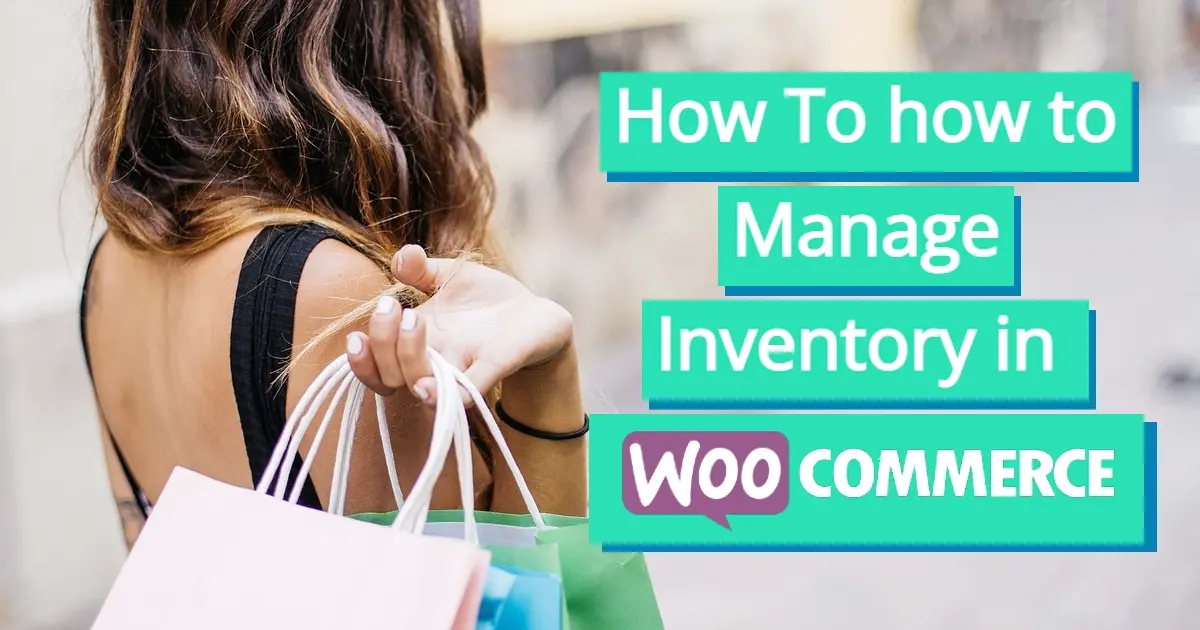Did you know that you can manage inventory in WooCommerce? If not, now you do. This feature in WooCommerce will help you keep on top of how much you sell of your products, so you don’t run out. In this article, you’ll learn about how to manage inventory in WooCommerce.
What is WooCommerce?

WooCommerce is one of the most powerful ecommerce systems in the market that works hand-in-hand with WordPress. It is so powerful that it has over 36.68% market share in 2022 and blows away most other ecommerce solutions, both add-ons for other CMS, and stand-alone 3rd party services.
WooCommerce is free to use and includes a lot of tools out of the box like:
- In-depth product organization into categories, tags, and more
- Inventory management
- [Shipping options](https://verpex.com/blog/website-tips/how-to-create-a-dropshipping-website
- Tax calculation in conjunction with the Jetpack plugin
- Ability to sell tangible and digital items
- Sales reports
- Ability to scale up as your store grows
- Multiple payment gateways
- Options for compatible themes
- Works with the Gutenberg content block editor or the Classic editor
- Options for product variations
- Product editor with gallery features
…and much more! If you need specific shipping, subscription based products, membership capabilities, courseware features, or more, you can check out the premium add-ons at WooCommerce.com.
How to Manage Inventory in WooCommerce: 5 Ideas
Here’s some areas to know when you manage inventory in WooCommerce:
- How does WooCommerce Inventory management work
- How to setup WooCommerce inventory
- How to manage a single product’s stock status
- How to manage a single product’s variable stock status
- How to keep inventory in WooCommerce updated
How does WooCommerce Inventory management work
WooCommerce inventory assists you on tracking how much product you have, and how much you’ve sold. This is a feature that ships by default with WooCommerce. Now there are some plugins that are free or premium paid ones that can extend this feature, but for most, the default options should be okay for most WordPress powered ecommerce sites.
The plugin tracks products, so when your customer’s buy something, the inventory will automatically detract from the number of items available. Additionally, you can track customer orders and their shipping status. This will help in preventing customers from ordering products that aren't available, and even tell you what items are selling well.
The only downsides WooCommerce can’t track are things like raw materials used for your products, and when you need to add more items, you need to manually increase the number of stock.
How to setup WooCommerce inventory
To access your WooCommerce inventory options, you will need to go to WooCommerce > Settings > Products > Inventory in your WordPress admin area.

You will want to make sure that the option for “Enable stock management” is ticked. It’s also best to tick the options to receive an email if your stock is low or out. You can also set the minimum threshold for low stock and out of stock, which is great so you can figure out if you need to get more products, or be prepared to tell customers that you’re out of stock.
How to manage a single product’s stock status
Now that you’ve set the general options for allowing inventory management, you need to set each of your product’s stock. To access this, create a product and go to the Product data box. This box will have a few tabs. The one you’ll want is labeled “Inventory”.
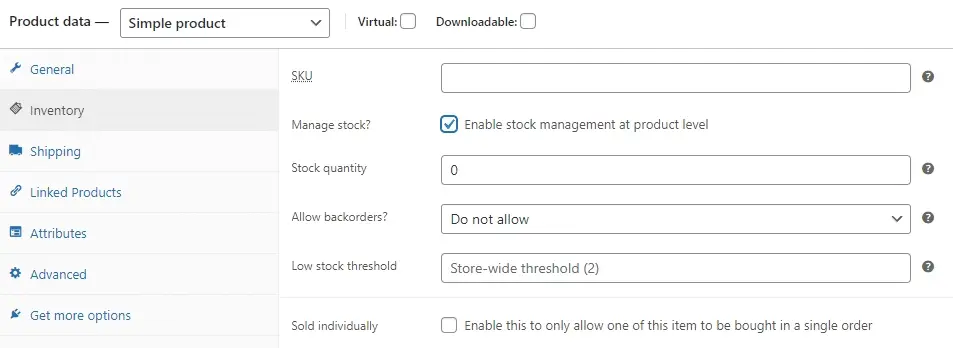
Some areas to note:
- Sku
- Manage stock?
- Stock quantity
- Allow backorders
- Low stock threshold
- Sold individually
Sku
A sku is short for stock keeping unit. This is a set of numbers or combination of letters and numbers that are assigned to a single product. If you have variations of the product, the sku will be different. For example, if you sell t-shirts and a plain white t-shirt has a stock number of TS-001, you would label different sizes and colors with a different sku number.
Manage stock?
If you wish to manage the individual products stock, you should tick the box.
Stock quantity
Stock quantity is how many products you have available for sale of that item.
Allow backorders
If you have a popular item that either has sold out or you’re introducing something new, you can allow customers to backorder the item, so when it is in stock, they will receive the item.
Low stock threshold
You can adjust each individual product's low stock threshold to be different from your general settings. This is great in case you have a limited number of products or one that is in demand, and want to be cautious on getting it in stock faster.
Sold individually
If you’ve got a popular item and don’t want people to mass purchase it, you can opt to tick the sold individually so customers can only purchase one of that product per order.
How to manage a single product’s variable stock status
A variable of a product is one where it is not the same as the original listed product. With WooCommerce, you can manage the stock status of each variable. This means that if you have four different shirt sizes and several colors, you will need to list each variable and tell WooCommerce how many of each that you have in stock.
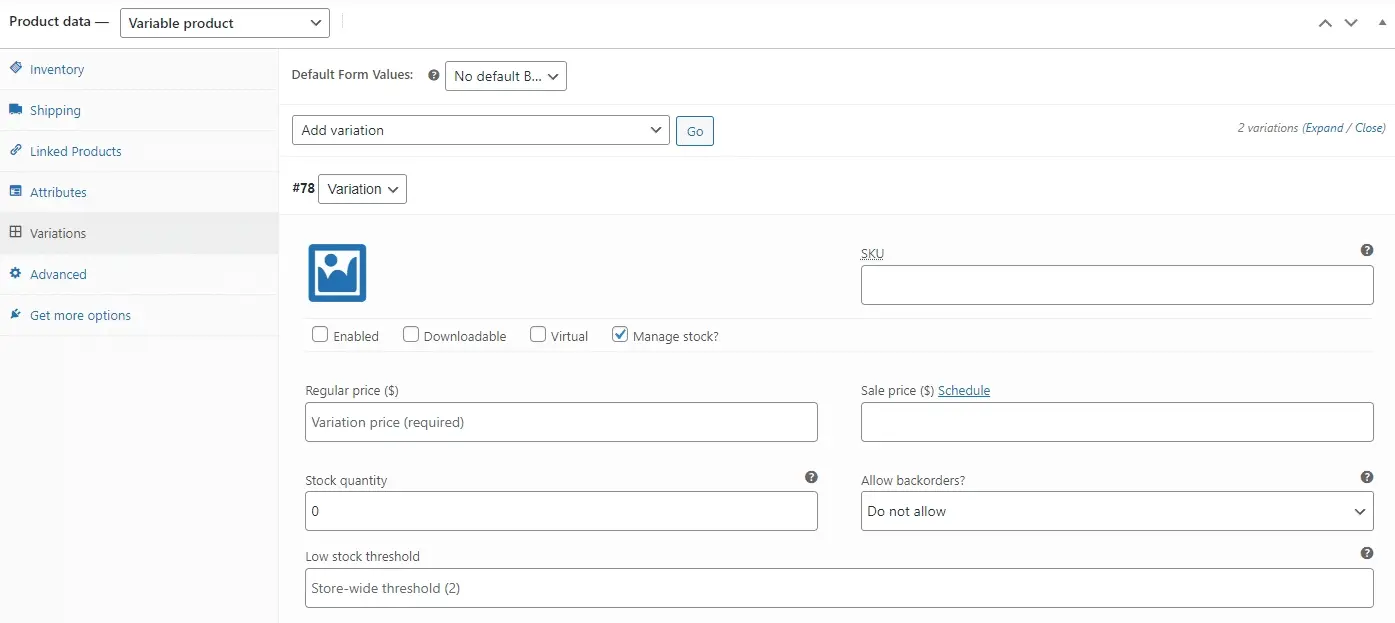
Each variable has similar options for stock quantity, and low stock threshold.
How to keep inventory in WooCommerce updated
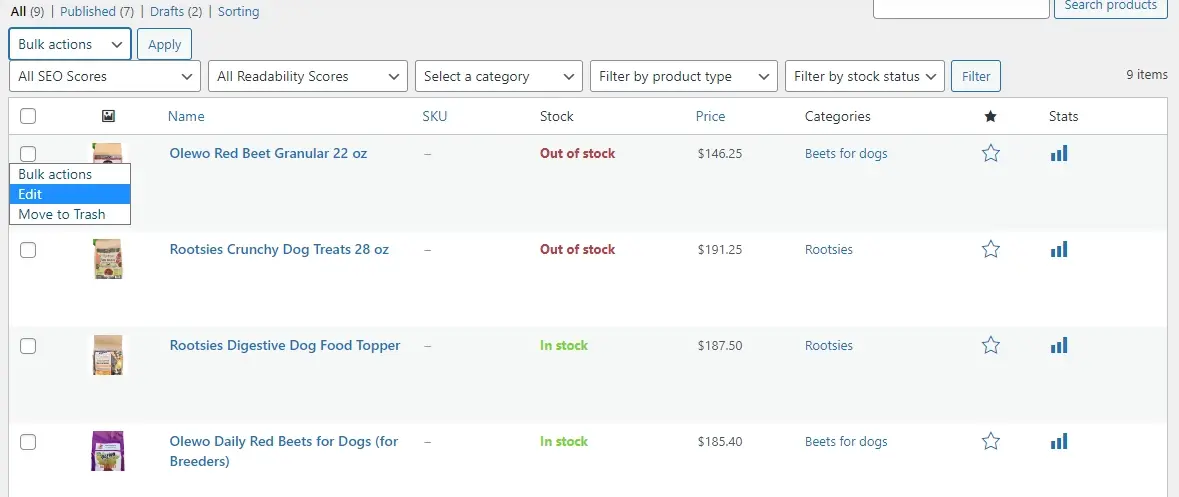
You can either bulk edit your inventory from the list of products under Products > All Products, or individually.
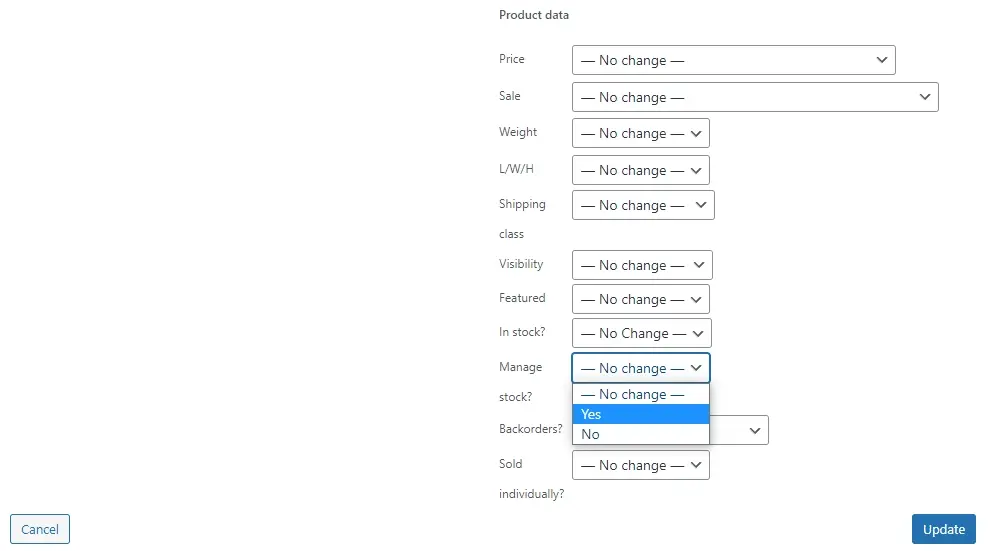
When bulk editing, you can select Yes to the dropdown field next to “Manage Stock”.
In case you need an overview of your stock list to get a much better idea on how things are going, you can go to Analytics > Stocks. You can see if items are in or out of stock, or even if they are low in stock, or on backorder.
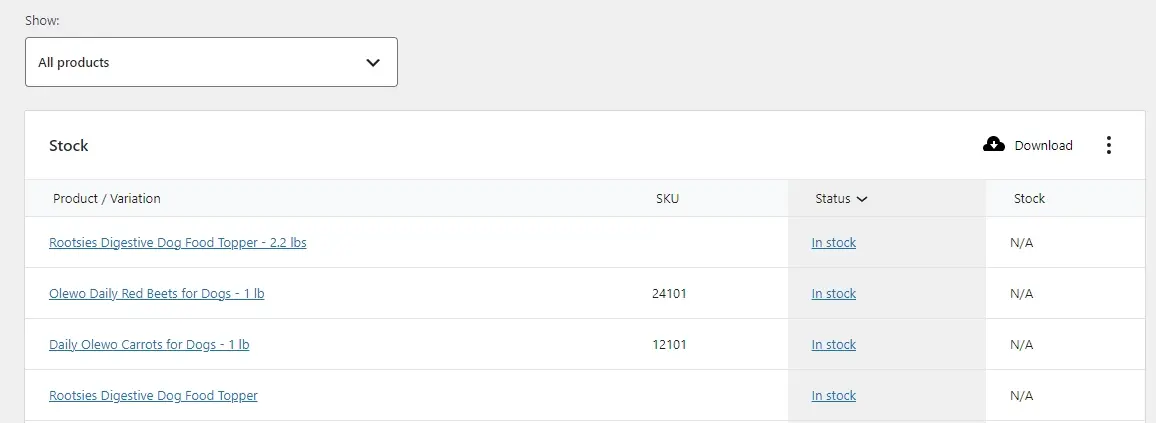
Plugins to Help Manage Inventory in WooCommerce
Below are some free plugins to help manage inventory in WooCommerce.
- ATUM WooCommerce Inventory Management and Stock Tracking
- Product Import Export for WooCommerce
- Stock Locations for WooCommerce
- Stock Manager for WooCommerce
ATUM WooCommerce Inventory Management and Stock Tracking

ATUM WooCommerce Inventory Management and Stock Tracking creates a streamlined experience for managing stock, and tracking sales. This plugin includes some of the following features:
- Stock control system
- Lists all WooCommerce products on one screen
- Image thumbnail display option on product list
- Option to display a short name or the sku for the product list
- Filter by supplier
- Bulk editing of products
- In-depth sales reports
- Ability to customize visual appearance of stock central
- Help section
- Advanced search with auto-fill capability
- Inventory and stock filters
- Support for variable products
- Compatible with WPML for multiple languages
- Ability to export inventory to PDF
Product Import Export for WooCommerce

Product Import Export for WooCommerce allows you to import or export your data from your WooCommerce store, that is geared toward helping you to manage inventory. This plugin gives you many options on fine tuning exactly what you want to export. For example, if you only want to download inventory from one category of products, you can do so.
Stock Locations for WooCommerce

Stock Locations for WooCommerce is handy if you manage different locations. In the case you have different physical stores or warehouses, this plugin can help with that. It adds a new taxonomy (example: categories and tags) for locations. This plugin works with variable products.
Additionally, your customers can opt to select from a specific location when ordering a product, if multiple locations are available to choose from.
Stock Manager for WooCommerce

Stock Manager for WooCommerce allows you to manage all stock for your products, whether they are stand alone or a variable. You can even manage areas like: product stock status, quantity, prices, SKU, and taxes. This plugin also includes the ability to import and export stock data to a spreadsheet.
Having a well-organized inventory system is crucial to the success and profitability of any WooCommerce store. That's why it's critical to use a reputable hosting service. If you're looking for a web host, we encourage you to take a look at our packages and take advantage of the many useful features and top-notch support we provide.
In Summary
Hopefully this walkthrough on how to manage inventory in WooCommerce will help you stay on top of your shop's products. Go ahead and play around with the inventory management options in WooCommerce and see what works for you. Happy selling!
Frequently Asked Questions
Do I need web developer skills to use Shopify or WooCommerce?
No. Both platforms welcome beginners, but you might get more out of WooCommerce’s extensions if you’ve got some previous experience.
How easy is it to switch between WooCommerce and Magento?
At Verpex we can host either site no problem. However, you’ll need to be aware that there can be some difficulties due to the customizable nature of Magento, and functionality could be lost.
How long does It take to set up a WooCommerce store?
You can install WooCommerce to your WordPress site with just one click. Then, you just need to add your products and you’re off. You could be up and running in just a few hours.
How much does WooCommerce hosting cost?
Prices are very reasonable and start from just $2.99 per month at Verpex.

Nile Flores is a long time professional blogger, as well as WordPress website designer and developer from the St. Louis Metro East. Nile blogs at NileFlores.com, where she’s passionate about helping website owners, whether they’re small business owners or bloggers. She teaches about Blogging, Social Media, Search Engine Optimization, Website Design, and WordPress. Additionally, Nile loves to speak at WordCamps (WordPress conferences) across the United States. When Nile isn’t knee-deep in coding, she’s a proud mom of a college student, and enjoys oil painting, cigar smoking, nail art design, and practicing traditional Okinawan kempo karate.
View all posts by Nile Flores















